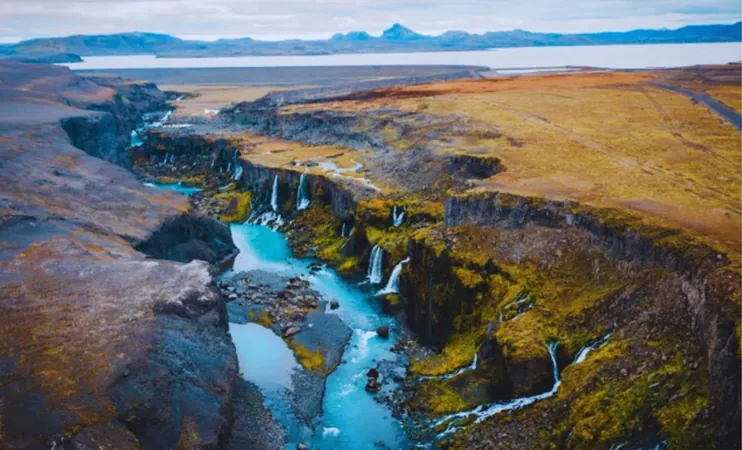
Earth's Biggest Geography Shocker: Scientists Unveil Only Six Continents—North America and Europe as One!
2025-01-22
Author: Kai
Groundbreaking Research
Prepare to have your world turned upside down! Recent groundbreaking research from Dr. Jordan Phethean and his team at the University of Derby suggests that our understanding of Earth's continents is fundamentally flawed. Forget the commonly taught notion of seven continents divided by vast oceans. Dr. Phethean's shocking revelation indicates that Earth may only possess six continents, merging North America and Europe into one colossal landmass.
Challenging Long-Standing Beliefs
For decades, scientists believed that the North American and Eurasian tectonic plates had completely separated around 52 million years ago, giving rise to the Atlantic Ocean and defining the two continents. However, this latest research challenges that long-held view by proposing that these tectonic plates are still in the process of splitting apart, meaning they may actually constitute a single supercontinent yet to be recognized.
The Role of Iceland
Interestingly, Iceland takes center stage in this thrilling geological saga. This volcanic island, long regarded as unique, now appears to be the crucial connection point that ties North America and Europe together. Dr. Phethean’s team posits that Iceland and the nearby Greenland-Iceland-Faroes Ridge aren't just isolated geological features. Instead, they harbor fragments of both the North American and Eurasian tectonic plates, suggesting that what we perceive as two separate continents may actually be a large interconnected geological structure known as a 'Rifted Oceanic Magmatic Plateau' (ROMP).
A Geological Atlantis
Dr. Phethean himself likens this discovery to a 'geological Atlantis,' revealing hidden remnants of a lost continent lying beneath the waves. If validated, this paradigm-shifting research could compel us to completely revise our understanding of Earth’s geography, eliminating the tidy concept of seven continents in favor of a more fluid six-continent model.
Emerging Evidence
As bizarre as this concept may sound, emerging evidence continues to support it. Iceland’s unique geological features draw parallels with the tectonic connections observed in the Afar region of Africa, hinting that the tectonic plates we classify as continents might be more intricately connected than we ever imagined. This fluidity emphasizes that instead of being static landmarks, continents are dynamic and endlessly evolving entities influenced by shifting tectonic plates.
Ongoing Research
Dr. Phethean's earlier discovery of a 'proto-microcontinent' submerged between Canada and Greenland underscores the ongoing shifts within Earth's surface. This submerged landmass—about the size of England—further reinforces the idea that the continents are in continuous motion, revealing yet another facet of how Earth's geography is far more complex than taught in textbooks.
Future Plans
What's next for Dr. Phethean and his dedicated team? They are digging deeper into the mysteries of Earth's geology with sophisticated computer modeling and simulations that could expose ancient intercontinental links. Plans for intensive analyses of volcanic rocks in Iceland aim to confirm the potential presence of ancient crust.
Implications of Findings
The implications of these findings extend beyond mere academic curiosity; they may redefine resource exploration strategies and enhance predictions about future geological changes. Moreover, they could alter our view of Earth's history. Could there be even more undiscovered landmasses lying beneath the Atlantic? What other secrets might our planet be hiding?
Conclusion
As we embark on this thrilling journey into the Earth's dynamic past, one thing is clear: our understanding of the planet we call home is evolving rapidly. Prepare to rethink everything you thought you knew about geography, as the unraveling of Earth’s mysteries continues to fascinate and provoke thought. Stay tuned, the story is just beginning!



 Brasil (PT)
Brasil (PT)
 Canada (EN)
Canada (EN)
 Chile (ES)
Chile (ES)
 Česko (CS)
Česko (CS)
 대한민국 (KO)
대한민국 (KO)
 España (ES)
España (ES)
 France (FR)
France (FR)
 Hong Kong (EN)
Hong Kong (EN)
 Italia (IT)
Italia (IT)
 日本 (JA)
日本 (JA)
 Magyarország (HU)
Magyarország (HU)
 Norge (NO)
Norge (NO)
 Polska (PL)
Polska (PL)
 Schweiz (DE)
Schweiz (DE)
 Singapore (EN)
Singapore (EN)
 Sverige (SV)
Sverige (SV)
 Suomi (FI)
Suomi (FI)
 Türkiye (TR)
Türkiye (TR)
 الإمارات العربية المتحدة (AR)
الإمارات العربية المتحدة (AR)